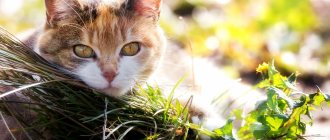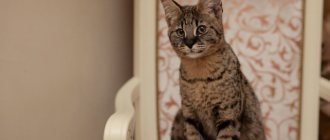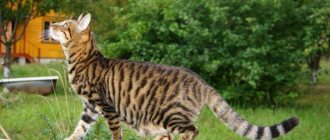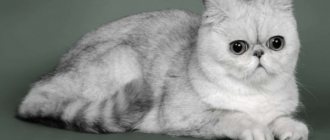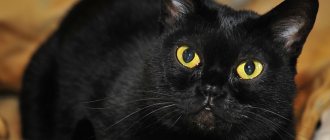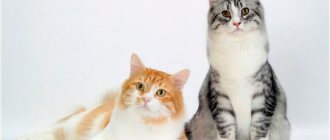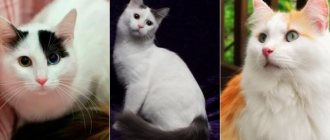- Cats
The Anatolian cat is little known among ordinary people who do not have specific felinological knowledge. Therefore, people often confuse it with representatives of the Angora breed. After reading today's publication, you will learn a lot of interesting things about these animals.
Origin story
The country is proud of them! This is usually what they say about native cat breeds. The homeland of “no problem cats”, Turkey, can call Anatolian cats its national pride! Turkish Shorthair cats are considered naturally formed. Once upon a time they appeared on their own in the vicinity of the Turkish Lake Van.
Afterwards they were noticed by breeders who appreciated the “wild look” of lake nymphs.
30 years ago, Anatolian cats were first presented to the public at an exhibition in Germany. The case took place in the city of Castrop-Rauxel and then the honor of the breed was defended by three Turkish graces - the odd-eyed cats “van kedisi” (Turkish: “cat from Van”). Turkish purrs have received the most rave reviews. Since then, the domestic period began in the life of Anatolian cats.
Already in 2000, Anatolian cats were registered as a breed (a variant of the Turkish Van) in the World Cat Federation.
Keeping an Anatolian cat
Anatolian cats do not require regular and thorough hygiene procedures. You only need to comb your pet during the molting period; the rest of the time, he copes with personal hygiene on his own. Short hair without a thick undercoat does not cause problems for either the cat or the owner.
Anatolian cats are clean and can take care of themselves.
Anatoli, unlike many other cats, has a positive attitude towards water. Bathing not only does not scare them, but also gives them pleasure. The fact that their fur quickly returns to its original state after getting wet only adds to the advantages of water games. Despite their love of water, veterinarians do not recommend bathing your Anatolian cat too often. It is enough to periodically clean your pet’s ears with a cotton swab and occasionally the eyes.
The teeth of an Anatolian cat require mandatory care, since a homemade diet can provoke not only the deposition of tartar, but also the development of inflammatory processes. In pet stores you can purchase a special medicated paste for these purposes; the toothbrush should not be too hard.
The Anatoli ancestors were excellent hunters and fishermen. The domestic breed inherited from them very strong, sharp and quickly growing claws. They do not wear off on their own, so they definitely need regular manicures.
The lifespan and physical condition of Anatolian cats directly depends on the conditions that the owner can create for them. For the full development of a pet, only three factors are needed:
- balanced, well-structured diet;
- sufficient and regular physical activity;
- absence of psychological stress and emotional overload.
Representatives of the Anatolian cat breed do not require any special conditions and live quite comfortably in apartments and private houses. To prevent your cat from getting bored while staying at home alone, you can buy her several different toys, or even better, install a play set.
Description of the breed
The Anatolian cat comes in several colors. The standard prohibits Siamese, chocolate, and cinnamon colors.
- The head is medium, triangular. Muzzle with high cheekbones and a powerful chin.
- The ears stand high and vertical. Wide at the base, rounded towards the tips, large. There are characteristic markings with a separating white blaze.
- The eyes come in different colors, oval, slanting, and large.
- The neck of the Anatolian cat is strong, well developed, massive.
- The Anatolian cat breed has large bones and developed muscles. In terms of weight, cats reach 5 kg, males 7. Kittens of the Anatolian breed are never small. They grow quickly and are stocky.
- The tail of the Anatolian cat is of medium length, mobile. The color is one tone darker than other parts of the body.
- The limbs are of medium length and quite strong.
- The color of the Anatolian cat, recognized as the standard, is white, red, tortoiseshell, gray, black, blue.
- The coat is short, thick, extremely fine. Water repellent. Kittens of the Anatolian breed have virtually no undercoat. The coat is smooth, soft, silky.
Advantages and disadvantages
Let's look at the pros and cons of Anatolian cats.
| Advantages | Flaws |
| Good genetic inheritance, thanks to which cats have good health and strong immunity. The short and not very thick coat does not require constant careful grooming. Non-aggressive and kind disposition. They are well trained and can be trained. Wide color spectrum of wool. | It is difficult to find a kitten because the breed is very rare. An ordinary appearance, which not everyone likes. High price. |
Character
As for the character of the Anatolian beauty, it should be noted that they have a lively mind and perfectly record the surrounding environment in their memory: house rules, family members. There are usually no problems with them when training them to use the tray. Preferred pastimes include playing with rustling objects, as well as the habit of carrying small (and not so small) objects in the teeth. The owners of such animals say that you can even train them to carry slippers.
You won't hear meows from cats of this breed. Rather, the sounds they make are more like snorting or chirping. They also love to communicate with their owners with gestures and, oddly enough, facial expressions, and can beat the beat with their tail to musical rhythms.
Cat care
There is no need to clean up after your cat; she takes care of her own cleanliness. There will be some fur in the house only when the cat begins to shed.
She needs help combing her fur faster so that less gets into her stomach.
The animal needs to be bathed rarely, but the ears need to be cleaned often – every 3 days. For cleaning you need cotton swabs, but not sticks. Sometimes a cat needs to rub its eyes .
You can trim your cat's claws only if it does not go outside. If she often visits the yard, then her claws cannot be cut; here she may face various troubles, in the form of stray dogs, from which she will have to hide in a tree.
The Anatolian cat is very clean, and may refuse to go to a dirty litter box several times..
Breeding work
The Anatolian breed is a closed breed; mating with Angoras, Vans and other breeds is prohibited, which is still practiced by some unscrupulous breeders. Breeding strategies must be unified, aimed at developing and improving the best qualities of the Turkish Shorthair cat, stabilizing its phenotype and gene pool.
Breeding Anatolian cats
Like most native cats, Turkish Shorthairs mature very early - by the age of six months they become sexually mature and theoretically can give birth to offspring. In practice, the complete physical and psychological formation of representatives of the breed is completed only by two to three years. Before this age, animals should not be included in breeding programs.
The difficulty of breeding work with this breed lies primarily in the fact that the population of Anatolian cats is numerically limited. It is very difficult to find a decent pair of sires, and breeders often go so far as to breed only their own animals within the nursery - this is much simpler and cheaper. But thereby the genetic combinations of the offspring are repeated, impoverishing the diversity of the breed's gene pool.
Similar problems are relevant for all rare and small breeds. There are no quick solutions - only through the systematic work of breed enthusiasts can its full development, popularization and growth take place. But for this, approaches to breeding Anatolian cats must be competent, professional and thought out several steps ahead. Matings “for health” in this case are categorically unacceptable.
Love is not at all superfluous in breeding work
The future parents are brought together in the cat's territory and left there for the cat's hunting period. If the couple’s relationship works out, then in a little over two months we should expect the birth of heirs. In preparation for such an important date, both producers must be examined by a veterinarian and undergo antiparasitic treatment.
Quite often this breed has multiple litters, but the cubs are usually born large, which can complicate the birth process. Therefore, agree with your doctor in advance so that he can help the woman in labor if necessary, although in most cases cats do an excellent job on their own.
The Anatolian cat becomes a very caring mother
If happy parents, a cat and a cat, live in the same house, then they raise their children together. In other breeds such a family idyll can be observed extremely rarely. Kittens usually go to new families after three months of age, when they are ready to live without their parents and are fully vaccinated.
Video: caring mother with kittens
Castration and sterilization
Animals that will not participate in exhibition and breeding activities are often castrated or neutered. Such surgical intervention can be performed either at the request of the owners, or at the request of the breeder, or for medical reasons. The optimal age for surgery is from eight months to a year, when the animal has already entered puberty and is sufficiently formed and strong.
Both the operation itself and the monitoring of the critical rehabilitation period should be carried out by experienced veterinary specialists. To ensure the safety of the stitches and their fastest healing, it is recommended to put a special protective blanket on your pet - you can sew it yourself or purchase it at a pet store.
Health
The Anatolian cat is known for its good health. It underwent natural selection in natural conditions, was not subject to the work of breeders and, largely due to this, does not suffer from genetic diseases typical of artificially bred breeds.
Diseases that can threaten the Turkish Shorthair are common to cats: difficult childbirth, urolithiasis caused by an unbalanced diet, infections, helminthiasis and other parasites. The latter is not uncommon because Anatolians are naturally curious and love to be outside. Therefore, it is necessary to carry out preventive measures in a timely manner:
- vaccinate;
- worminess;
- Inspect the fur and inner surface of the ears for the presence of fleas and ticks.
Maintenance and care
The Turkish Shorthair cat is a real joy for any owner. They do not require special attention and do not cause unnecessary trouble; these animals are able to take care of themselves. The owner can only control how well they coped with their task.
Short hair dries quickly and does not tangle; you can comb the cat only during periods of intense shedding: this will protect the pet from stomach problems and the apartment from excess litter. It is imperative to clean your cat’s ears and eyes: this procedure must be carried out from the first days of life.
The care and maintenance of an Anatolian cat has only one nuance: Turkish fluffies do not know how to care for their claws. It’s better, of course, not to touch them at all, especially if you plan to go outside. Turks have no inclination towards mischief and mischief, and, having been accustomed to scratching posts since childhood, will not encroach on furniture and wallpaper.
Purchasing a kitten
Turkish beauties are still not very common outside their homeland, and in Europe there are not many catteries where you can buy an Anatolian cat.
In Russia, only private breeders breed these animals, and the cost of kittens of this breed can vary significantly. The price of an Anatolian cat, as a rule, varies from 10 to 30 thousand rubles.
The Anatolian cat, with its exotic oriental appearance and predatory grace, has those advantages for which people love these furry creatures so much. A Turkish beauty with a snow-white fur coat and eyes the color of a summer sky will become a faithful and affectionate friend for the owner and will give him all the tenderness that her sincere loving heart is capable of.
How to choose an Anatolian kitten
The first nurseries of the Anatolian breed have recently appeared in Russia, which, of course, will simplify and reduce the cost of purchasing a kitten. Previously, purebred Turkish Shorthairs could only be bought in Europe or Turkey. The cost of a “pet” class baby starts from five hundred dollars. Buying a breeding or exhibition specimen will cost you three to four times more. Such a high price is due to the fact that the breed still remains quite rare - and, as we know, you have to pay for exclusivity.
Promising show class kittens are very expensive
The aboriginal origin of the Anatolian makes this expensive and rare animal look like an ordinary yard pussy. Often, only an experienced specialist will be able to discern breed characteristics in a small kitten. This circumstance is readily taken advantage of by scammers who offer completely outbred, albeit very cute, babies under the guise of an Anatolian cat.
This cute outbred baby was offered for sale as an Anatolian kitten
To avoid becoming another victim of deceivers, you need to buy a kitten not from random dubious dealers, but only from professional nurseries. Of course, even with such a correct approach, you can stumble upon unexpected pitfalls.
There are known cases when some unscrupulous breeders passed off culling of other breeds as Anatolians: the same Vans or Angora cats (sometimes short-haired babies are born in their litters). And the temptation to sell a breed marriage for substantial money, presenting it as an “Anatolian breed,” sometimes outweighs basic decency.
The magic word “kennel” should not become decisive and final in your choice - make inquiries about breeders, read reviews about their work. If you have the Internet, it is not a big problem to find out at least what breeds a given nursery specializes in.
Ask the breeder to show your kitten's littermates
Carefully read the standards of breeds similar to the Anatolian - their main differences have already been described in this article. Ask the breeder for as many photos and videos as possible of both the proposed baby and his parents, and study their documents together with the specialists. And if personal contact is possible, just stroke the kitten: even the Anatolian baby’s fur is so specific that it is impossible to confuse it. The short fur is both stiff and silky; it creaks slightly under your hand.
When purchasing a kitten, enter into an agreement with the breeder
And most importantly, buy an Anatolian kitten only under an officially certified contract with the breeder. This, of course, is also not one hundred percent, but still a guarantee that you will not be deceived for your own money.
Video: Anatolian kittens playing
Owner reviews
# review 1
This is an extremely elegant and friendly creature. She herself chose us at the exhibition, ran up and began to ask to be held in our arms. The distinctive features of Anatolian cats are grace and a quiet voice. Ours doesn’t know how to meow at all, which is why we thought she was “defective.” Then we figured out that the barely audible “ma-ma” in the morning (instead of the usual “meow”) is the calling card of the Anatolian breed. The cat is suitable for those who love sociable pets. Ours manages to stick her nose into all household chores and be with all family members, depriving no one of her attention.
With the beginning of the summer season, we decided that it was time to make our pet a rat catcher, and hoped that she would catch all the surrounding mice. Not so! Our beauty ran around the country house like a hippopotamus, and, of course, scared away all the rodents with her stomping. We thought that we should first show her a live mouse, for which we caught the mouse and put it in a box, bringing it right under the cat’s nose. The mouse was so frightened that it stopped breathing, and our princess extended her paw and immediately pulled it away with disgust, and even shook it, as if shaking off something nasty. She turned away and left. Apparently, Anatolian cats do not catch mice.
# review 2
We bought an Anatolian cat in Turkey when we were on vacation there. The breed is rare in our area, so I am proud of my beauty. She is a smoky gray color with beautiful, intelligent eyes. He understands instantly what is possible and what is not. She participates in everything, nothing can be done without her: she brings slippers in the morning, she brings me my cell phone when he calls. Loves to wander through tall grass, not forgetting to chew it. But most of all, like a real predator, she loves meat.
Video
Feeding
Nutrition plays an important role in raising a healthy pet. Small kittens without a mother are usually fed special formulas or goat's milk. Read how to feed a kitten without a cat mother.
The number of meals for growing cats should be 5 times a day, for adults - 2 times.
Cats willingly eat both homemade (natural) and store-bought food. In the latter case, you need to take food marked “holistic” or “super premium”, since these foods are the most balanced and do not contain harmful additives, unnecessary corn, wheat, etc.
Among the required products it is worth highlighting:
- Fresh beef, chicken or turkey, offal.
- Sea fish.
- Fermented milk foods.
- Boiled eggs.
- Cucumbers, carrots, zucchini, young grass.
- Rice or buckwheat.
